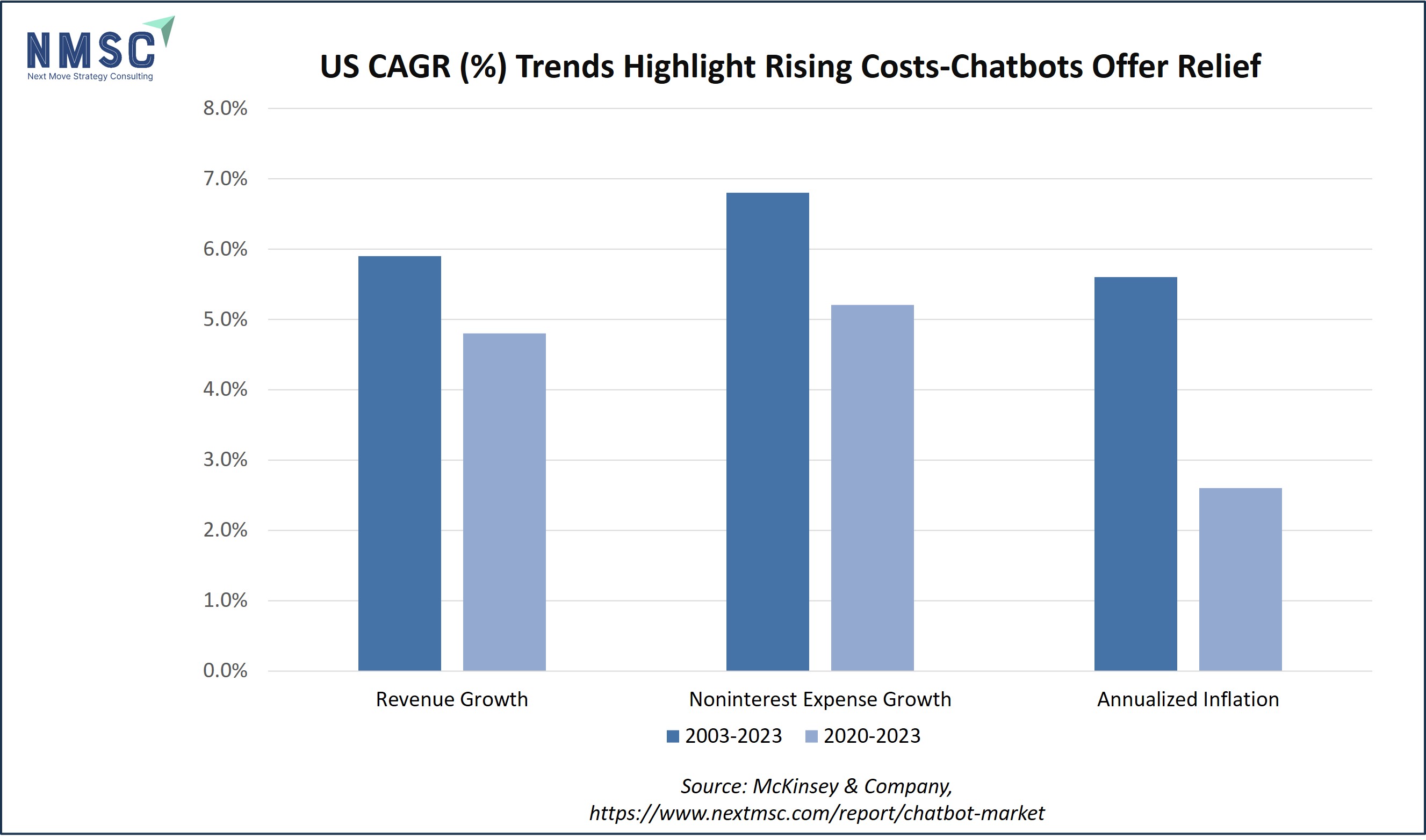What’s Fueling the Growth of the Chatbot Market?
Published: 2025-09-10

Chatbots are no longer just digital assistants—they are becoming central players in healthcare, government, and humanitarian systems. Their ability to enhance communication, reduce operational load, and provide scalable services is fueling remarkable growth across sectors.
Let us explore the key factors accelerating chatbot adoption today, backed by credible and current sources.
Rising Healthcare Demand: From Symptom Checkers to Mental Health Support
Chatbots are now integral to modern healthcare infrastructure. One of the biggest drivers is their ability to provide cost-efficient, 24/7 support—especially in resource-constrained systems.
A 2024 study in Frontiers in Psychology highlighted how AI chatbots have supported mental health interventions, reporting “statistically significant improvements in users’ well-being and emotional self-regulation”.
Meanwhile, the Journal of Medical Internet Research emphasized the chatbot’s role in chronic disease management and triage, underscoring their value in early diagnosis and care optimization.
Summary:
-
Chatbots reduce the burden on healthcare systems.
-
They are proving effective in supporting mental health and chronic care.
-
Health-sector chatbot adoption is accelerating due to evidence-backed efficacy.
Key Points:
-
24/7 support helps in underserved areas.
-
Proven psychological benefits from guided interactions.
-
Scalable solution for high-volume public health needs.
Government Chatbots: A New Standard in Civic Engagement
Governments have quickly realized the utility of chatbots in enhancing public service delivery. According to Government Technology, by early 2025, over 250 U.S. city and state governments had deployed chatbots to handle tasks such as license renewals, disaster alerts, and tax assistance.
These tools help improve accessibility, reduce response time, and free up personnel for complex tasks. The shift has been particularly impactful in multilingual and underserved communities.
Summary:
-
Chatbots are now essential tools for state and municipal services.
-
Their multilingual capacity and availability improve inclusivity.
Highlights:
-
Over 250 government deployments in the U.S. alone by 2025.
-
Use cases: crisis alerts, tax filing help, licensing services.
-
Reduced citizen waits times and improved workflow efficiency.
Public Health & Crisis Response: A Global Imperative
In global public health and humanitarian crises, chatbots have proven life-saving. A review on ResearchGate concluded that during outbreaks and emergencies, chatbots “effectively bridged the gap between overwhelmed systems and at-risk populations”.
Similarly, in humanitarian fields, chatbots are used to safely deliver information about landmine threats, disease prevention, and access to aid. The EORE 2024 report highlights successful deployments across conflict zones and refugee camps.
Summary:
-
Chatbots ensure real-time, accurate public communication in crises.
-
Deployment in war zones and refugee environments is increasing.
Impact Points:
-
Quick, scalable access to verified life-saving data.
-
Operate with low infrastructure—ideal for remote settings.
-
Build trust through consistent, multilingual messaging.
Cost Efficiency and Scalability: The McKinsey Perspective
According to McKinsey & Company’s 2024 chartbook, businesses and public sector bodies see cost savings of up to 30% in customer service when shifting to chatbot-based platforms.
Chatbots handle repetitive inquiries efficiently and escalate only complex queries to human agents. This hybrid model maximizes human talent while containing operational costs.
Summary:
-
Major cost reductions are driving chatbot adoption.
-
Blended human–bot service models are outperforming legacy systems.
Efficiency Highlights:
-
Up to 30% cost savings in support services.
-
High-volume automation without compromising personalization.
-
Enhances both customer experience and ROI.
Ethical Governance and Trust-Building
Trust remains essential. The World Economic Forum’s governance framework on healthcare chatbots stresses transparent design, ethical data usage, and inclusion as pillars of responsible deployment.
By 2025, organizations are increasingly adopting WEF’s “human-centric” principles, which include transparency in how AI makes decisions and strong consent protocols—key to building long-term public trust.
Summary:
-
Ethical governance is shaping user acceptance and sustainability.
-
Standards and protocols are solidifying across regions.
Key Governance Principles:
-
Human-centered design and ethical AI logic.
-
Clear data consent and transparency.
-
Multistakeholder oversight models encouraged.
Humanitarian Impact: Real Stories of Change
From Rohingya refugee camps to Ukrainian displacement zones, humanitarian chatbots are delivering critical updates in native languages, via SMS or simple mobile apps. EORE’s 2024 report details how these tools provided real-time minefield warnings, saving countless lives.
Summary:
-
Humanitarian chatbot use is growing fast due to reliability and simplicity.
-
Designed to work with minimal tech infrastructure.
Impactful Uses:
-
Multilingual delivery of health alerts and aid instructions.
-
Offline-capable chatbots deployed in war zones.
-
Life-saving intervention in the absence of formal communication channels.
Conclusion: Why Chatbots Are Taking Off
Chatbots are no longer optional. They are critical to scalable service delivery, especially where speed, cost, and access are non-negotiable. The combined forces of healthcare necessity, government digitization, crisis response, and economic efficiency are propelling chatbot adoption into the mainstream—globally and sustainably.
Next Steps: How Stakeholders Can Act Now
Here are five actionable insights for businesses, governments, and nonprofits:
-
Adopt Hybrid Models: Combine chatbots with human agents for optimal performance and cost savings.
-
Prioritize Ethical Design: Follow frameworks like WEF’s for data governance and transparency.
-
Invest in Health Tech Bots: Implement mental health and triage bots to reduce system overload.
-
Enable Offline Access: Ensure chatbots work on low-tech devices for humanitarian deployment.
-
Leverage Public Sector Templates: Replicate successful civic chatbot models from U.S. municipalities.
About the Author
 Sanyukta Deb is a seasoned Content Writer and Team Leader in Digital Marketing, known for her expertise in crafting online visibility strategies and navigating the dynamic digital landscape. With a flair for developing data-driven campaigns and producing compelling, audience-focused content, she helps brands elevate their presence and deepen user engagement. Beyond her professional endeavors, Sanyukta finds inspiration in creative projects and design pursuits.
Sanyukta Deb is a seasoned Content Writer and Team Leader in Digital Marketing, known for her expertise in crafting online visibility strategies and navigating the dynamic digital landscape. With a flair for developing data-driven campaigns and producing compelling, audience-focused content, she helps brands elevate their presence and deepen user engagement. Beyond her professional endeavors, Sanyukta finds inspiration in creative projects and design pursuits.
About the Reviewer
 Debashree Dey is a skilled Content Writer, PR Specialist, and Assistant Manager with strong expertise in Digital Marketing. She specializes in crafting visibility strategies and delivering impactful, data-driven campaigns. Passionate about creating engaging, audience-focused content, she helps brands strengthen their online presence. Beyond work, she draws inspiration from creative projects and design pursuits.
Debashree Dey is a skilled Content Writer, PR Specialist, and Assistant Manager with strong expertise in Digital Marketing. She specializes in crafting visibility strategies and delivering impactful, data-driven campaigns. Passionate about creating engaging, audience-focused content, she helps brands strengthen their online presence. Beyond work, she draws inspiration from creative projects and design pursuits.

















Add Comment